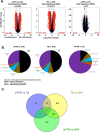Characterization of methylation profiles in spontaneous preterm birth placental villous tissue
- PMID: 36952446
- PMCID: PMC10035933
- DOI: 10.1371/journal.pone.0279991
Characterization of methylation profiles in spontaneous preterm birth placental villous tissue
Abstract
Preterm birth is a global public health crisis which results in significant neonatal and maternal mortality. Yet little is known regarding the molecular mechanisms of idiopathic spontaneous preterm birth, and we have few diagnostic markers for adequate assessment of placental development and function. Previous studies of placental pathology and our transcriptomics studies suggest a role for placental maturity in idiopathic spontaneous preterm birth. It is known that placental DNA methylation changes over gestation. We hypothesized that if placental hypermaturity is present in our samples, we would observe a unique idiopathic spontaneous preterm birth DNA methylation profile potentially driving the gene expression differences we previously identified in our placental samples. Our results indicate the idiopathic spontaneous preterm birth DNA methylation pattern mimics the term birth methylation pattern suggesting hypermaturity. Only seven significant differentially methylated regions fitting the idiopathic spontaneous preterm birth specific (relative to the controls) profile were identified, indicating unusually high similarity in DNA methylation between idiopathic spontaneous preterm birth and term birth samples. We identified an additional 1,718 significantly methylated regions in our gestational age matched controls where the idiopathic spontaneous preterm birth DNA methylation pattern mimics the term birth methylation pattern, again indicating a striking level of similarity between the idiopathic spontaneous preterm birth and term birth samples. Pathway analysis of these regions revealed differences in genes within the WNT and Cadherin signaling pathways, both of which are essential in placental development and maturation. Taken together, these data demonstrate that the idiopathic spontaneous preterm birth samples display a hypermature methylation signature than expected given their respective gestational age which likely impacts birth timing.
Copyright: © 2023 Brockway et al. This is an open access article distributed under the terms of the Creative Commons Attribution License, which permits unrestricted use, distribution, and reproduction in any medium, provided the original author and source are credited.
Conflict of interest statement
The authors have declared that no competing interests exist.
Figures




Similar articles
-
Unique transcriptomic landscapes identified in idiopathic spontaneous and infection related preterm births compared to normal term births.PLoS One. 2019 Nov 8;14(11):e0225062. doi: 10.1371/journal.pone.0225062. eCollection 2019. PLoS One. 2019. PMID: 31703110 Free PMC article.
-
Abnormal placental DNA methylation variation in spontaneous preterm birth.J Matern Fetal Neonatal Med. 2022 Dec;35(24):4704-4712. doi: 10.1080/14767058.2020.1863357. Epub 2020 Dec 17. J Matern Fetal Neonatal Med. 2022. PMID: 33327822
-
Differential placental methylation in preeclampsia, preterm and term pregnancies.Placenta. 2020 Apr;93:56-63. doi: 10.1016/j.placenta.2020.02.009. Epub 2020 Feb 11. Placenta. 2020. PMID: 32250740
-
The role of placental insufficiency in spontaneous preterm birth: A literature review.Eur J Obstet Gynecol Reprod Biol. 2024 Apr;295:136-142. doi: 10.1016/j.ejogrb.2024.02.020. Epub 2024 Feb 10. Eur J Obstet Gynecol Reprod Biol. 2024. PMID: 38359634 Review.
-
Role of the Placenta in Preterm Birth: A Review.Am J Perinatol. 2016 Feb;33(3):258-66. doi: 10.1055/s-0035-1570379. Epub 2016 Jan 5. Am J Perinatol. 2016. PMID: 26731184 Review.
Cited by
-
Associations between blood leukocyte DNA methylation and sustained attention in mid-to-late childhood.Epigenomics. 2023 Oct;15(19):965-981. doi: 10.2217/epi-2023-0169. Epub 2023 Nov 9. Epigenomics. 2023. PMID: 37942546 Free PMC article.
References
-
- Chawanpaiboon S, Vogel JP, Moller A-B, Lumbiganon P, Petzold M, Hogan D, et al.. Global, regional, and national estimates of levels of preterm birth in 2014: a systematic review and modelling analysis. The Lancet Global Health. 2018;7(Acta Obstet Gynecol Scand 56 1977):e37–46. doi: 10.1016/S2214-109X(18)30451-0 - DOI - PMC - PubMed

